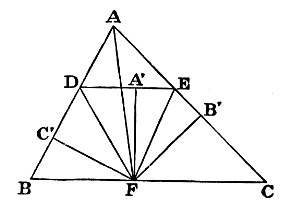In a given Triangle to place a line parallel to the base, such that the portions of sides, intercepted between it and the base, shall be together equal to the base.

Let ABC be the Triangle, and DE the required line, so that BD + CE = BC.
From BC cut off BF equal to BD; then CF = CE.
Join DF, EF.
Now ∠BDF = ∠BFD = [by I. 29] ∠FDE;
Similarly ∠CEF = ∠FED;
∴ ∠s BDE, CED are bisected by DF, EF, and F is centre of ⊙ escribed to △ ADE.
Drop, from F, ⊥s on BD, DE, EC; then these ⊥s are equal.
Hence, if AF be joined, it bisects ∠A.
Hence construction.
Bisect ∠A by AF: from F draw FB′, FC′, ⊥AC, AB: also draw FA′⊥BC and equal to FB′: and through A′ draw DE⊥FA′, i.e. ∥ BC. Then DE shall be line required.
∵ ∠s at A′, B′, C′ are right, and FA′ = FB′ = FC′,
∴ ∠s BDE, CED are bisected by DF, EF.
Now ∠BFD = ∠FDA′; ∴ it = ∠BDF; ∴ BF = BD;
Similarly CF = CE; ∴ BC = BD + CE.
Q.E.F.